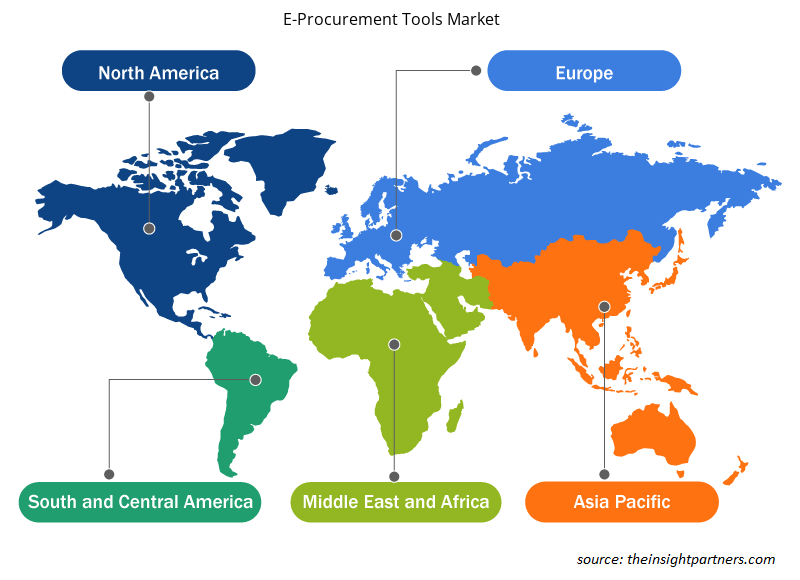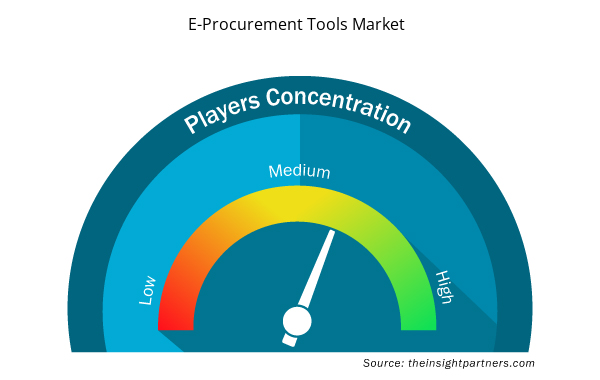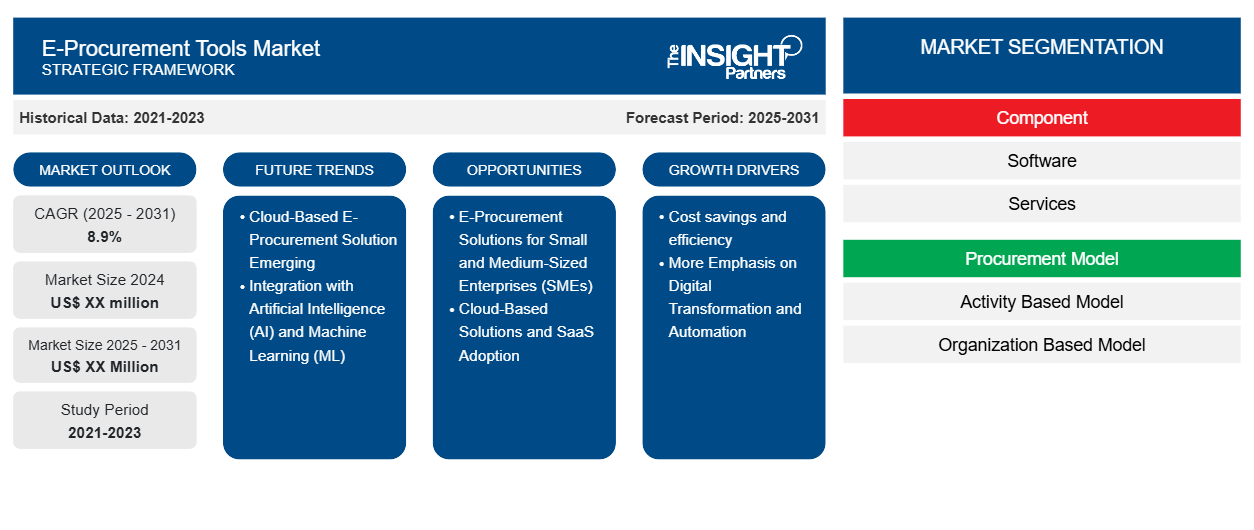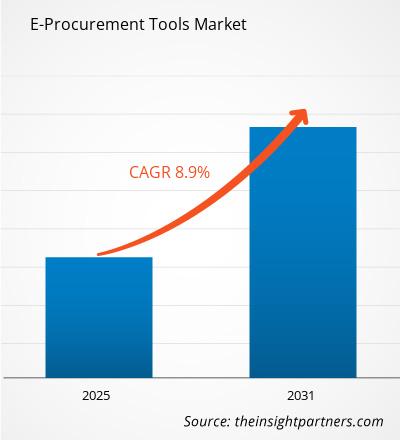電子調達ツール市場は、2023年から2031年にかけて8.9%のCAGRを記録し、市場規模は2023年のXX百万米ドルから2031年にはXX百万米ドルに拡大すると予想されています。
レポートは、コンポーネント(ソフトウェア、サービス)、調達モデル(アクティビティベースモデル、組織ベースモデル)、展開(オンプレミス、クラウド)、企業規模(中小企業、大企業)、業種(BFSI、ITおよび通信、教育、製造、食品および飲料、ヘルスケア、エネルギーおよび公共事業、その他)別にセグメント化されています。グローバル分析は、地域レベルと主要国でさらに細分化されています。レポートは、上記の分析とセグメントに対してUSDでの値を提供します。
報告書の目的
The Insight Partners による E-Procurement Tools Market レポートは、現在の状況と将来の成長、主な推進要因、課題、機会を説明することを目的としています。これにより、次のようなさまざまなビジネス関係者に洞察が提供されます。
- テクノロジープロバイダー/メーカー: 進化する市場の動向を理解し、潜在的な成長機会を把握することで、情報に基づいた戦略的意思決定が可能になります。
- 投資家: 市場の成長率、市場の財務予測、バリュー チェーン全体に存在する機会に関する包括的な傾向分析を実施します。
- 規制機関: 市場の濫用を最小限に抑え、投資家の信用と信頼を維持し、市場の完全性と安定性を維持することを目的として、市場における政策と警察活動を規制します。
電子調達ツール市場のセグメンテーション
成分
- ソフトウェア
- サービス
調達モデル
- アクティビティベースモデル
- 組織ベースのモデル
展開
- オンプレミス
- 雲
企業規模
- 中小企業
- 大企業
企業規模
- 中小企業
- 大企業
要件に合わせてレポートをカスタマイズする
このレポートの一部、国レベルの分析、Excelデータパックなど、あらゆるレポートを無料でカスタマイズできます。また、スタートアップや大学向けのお得なオファーや割引もご利用いただけます。
- このレポートの主要な市場動向を入手してください。この無料サンプルには、市場動向から見積もりや予測に至るまでのデータ分析が含まれます。
電子調達ツール市場の成長要因
- コスト削減と効率: 調達コストを削減し、全体的な業務効率を向上させることが、多くの企業が電子調達ツールを導入する主な理由です。電子調達プラットフォームでは、発注書、請求書承認、サプライヤー管理など、多くの作業を自動化できるため、調達プロセスが合理化され、管理コストが削減され、調達サイクルが短縮され、支出の可視性が高まります。一元化された調達により、企業はサプライヤーとより良い価格で交渉することができ、コスト削減にもつながります。
- デジタル トランスフォーメーションと自動化への重点: デジタル トランスフォーメーションのトレンドが拡大する中、企業は調達を含む社内業務のスムーズな流れを強化する自動化プロセスに注目するようになりました。電子調達ツールも、生産性の向上、ミスの削減、データ分析の精度向上を目的として、日常的なビジネス機能を自動化するという大きなトレンドの一部です。これらの電子調達システムを ERP、財務、サプライ チェーン管理と統合することは、今や総合的で効果的なビジネス運営に不可欠なものとなっています。
電子調達ツール市場の将来動向
- クラウドベースの電子調達ソリューションの登場: クラウド サービスはスケールアップやスケールダウンの柔軟性を提供し、同時にコストを節約できるため、クラウドベースの電子調達ツールは最近急速に普及しています。クラウド ソリューションの助けにより、高価なオンプレミス インフラストラクチャは必要なく、いつでもどこでも調達データにリアルタイムでアクセスできます。これにより、他のクラウドベースのビジネス ツールとの統合も可能になり、調達プロセスが改善されます。組織はクラウドベースのシステムを使用すると、ニーズに応じて迅速にスケールアップまたはスケールダウンできるため、あらゆる規模のビジネスに適合します。
- 人工知能 (AI) と機械学習 (ML) との統合: AI と機械学習のテクノロジーは、意思決定を強化し、調達プロセスを最適化するために、電子調達ツールに統合されています。AI は、サプライヤーの選択、需要予測のための予測分析、コスト削減の機会の特定などのタスクを自動化できます。ML アルゴリズムは、過去の購入データを分析して、最適なサプライヤーを推奨し、価格動向を予測し、在庫補充スケジュールを提案できます。この統合により、プロセスの運用効率が向上するだけでなく、企業のスマートでデータ主導の調達決定にも役立ちます。
電子調達ツールの市場機会
- 中小企業向け電子調達ソリューション: 大企業は長い間電子調達ツールを活用してきましたが、新たな機会はこれらのソリューションを中小企業向けにカスタマイズすることにあります。中小企業は一般的に大企業のようなリソースや高度な調達チームを欠いており、そのため手作業による非効率的な調達プロセスにますます依存することになります。スケーラブルで手頃な価格の使いやすい電子調達ソリューションは、中小企業が調達業務をデジタル化し、サプライヤー管理を改善し、コストを削減し、コンプライアンスを確保するのに役立ちます。これは、中小企業のニーズに合わせた価値重視の実装しやすいソリューションを提供できる電子調達プロバイダーにとって大きな成長の機会です。
- クラウドベースのソリューションと SaaS の採用: クラウドベースの電子調達ソリューションは、拡張性、初期費用の低さ、どこからでも簡単にアクセスできることから、急速に人気が高まっています。Software-as-a-Service (SaaS) モデルでは、企業はサブスクリプション ベースで電子調達ツールの料金を支払うことができるため、インフラストラクチャへの大規模な資本投資が不要になり、メンテナンスとアップグレードの負担が軽減されます。リモート ワークへの依存度が高まり、地理的に離れた場所でのリアルタイムのコラボレーションの必要性が高まる中、クラウドベースのソリューションにより、調達チームはどこからでも調達、承認、サプライヤー関係をより効率的に管理できます。柔軟性とコスト効率を高めるためにクラウドに移行する組織が増えるにつれて、この傾向は続くと予想されます。
電子調達ツール市場の地域別分析
予測期間を通じて電子調達ツール市場に影響を与える地域的な傾向と要因は、Insight Partners のアナリストによって徹底的に説明されています。このセクションでは、北米、ヨーロッパ、アジア太平洋、中東およびアフリカ、南米および中米にわたる電子調達ツール市場のセグメントと地理についても説明します。

- 電子調達ツール市場の地域別データを入手
電子調達ツール市場レポートの範囲
| レポート属性 | 詳細 |
|---|---|
| 2024年の市場規模 | XX百万米ドル |
| 2031年までの市場規模 | XX百万米ドル |
| 世界のCAGR(2024年 - 2031年) | 8.9% |
| 履歴データ | 2021-2023 |
| 予測期間 | 2025-2031 |
| 対象セグメント | コンポーネント別
|
| 対象地域と国 | 北米
|
| 市場リーダーと主要企業プロフィール |
|
電子調達ツール市場のプレーヤー密度:ビジネスダイナミクスへの影響を理解する
電子調達ツール市場は、消費者の嗜好の変化、技術の進歩、製品の利点に対する認識の高まりなどの要因により、エンドユーザーの需要が高まり、急速に成長しています。需要が高まるにつれて、企業は提供内容を拡大し、消費者のニーズを満たすために革新を起こし、新たなトレンドを活用し、市場の成長をさらに促進しています。
市場プレーヤー密度とは、特定の市場または業界内で活動している企業または会社の分布を指します。これは、特定の市場スペースに、その規模または総市場価値と比較して、どれだけの競合相手 (市場プレーヤー) が存在するかを示します。
電子調達ツール市場で事業を展開している主要企業は次のとおりです。
- ベヒトルAG
- クーパソフトウェア株式会社
- デルタ電子ソーシング
- ジェップ
- IBMコーポレーション
免責事項:上記の企業は、特定の順序でランク付けされていません。

- 電子調達ツール市場のトップキープレーヤーの概要を入手
主なセールスポイント
- 包括的なカバレッジ: レポートでは、電子調達ツール市場の製品、サービス、タイプ、エンドユーザーの分析を包括的にカバーし、全体的な展望を提供します。
- 専門家による分析: レポートは、業界の専門家とアナリストの深い理解に基づいてまとめられています。
- 最新情報: このレポートは、最新の情報とデータの傾向を網羅しているため、ビジネスの関連性を保証します。
- カスタマイズ オプション: このレポートは、特定のクライアント要件に対応し、ビジネス戦略に適切に適合するようにカスタマイズできます。
したがって、電子調達ツール市場に関する調査レポートは、業界のシナリオと成長の見通しを解読し理解する道の先導役となる可能性があります。いくつかの正当な懸念があるかもしれませんが、このレポートの全体的な利点は欠点を上回る傾向があります。
- 過去2年間の分析、基準年、CAGRによる予測(7年間)
- PEST分析とSWOT分析
- 市場規模価値/数量 - 世界、地域、国
- 業界と競争環境
- Excel データセット


- Battery Testing Equipment Market
- Predictive Maintenance Market
- Environmental Consulting Service Market
- Ceramic Injection Molding Market
- Aesthetic Medical Devices Market
- Artificial Intelligence in Defense Market
- Passport Reader Market
- Long Read Sequencing Market
- Customer Care BPO Market
- Cell Line Development Market

Report Coverage
Revenue forecast, Company Analysis, Industry landscape, Growth factors, and Trends

Segment Covered
This text is related
to segments covered.

Regional Scope
North America, Europe, Asia Pacific, Middle East & Africa, South & Central America

Country Scope
This text is related
to country scope.
よくある質問
Some of the customization options available based on the request are an additional 3-5 company profiles and country-specific analysis of 3-5 countries of your choice. Customizations are to be requested/discussed before making final order confirmation# as our team would review the same and check the feasibility
The major factors driving the e-procurement tools market are:
1. Cost savings and efficiency.
2.More Emphasis on Digital Transformation and Automation
Key players in the e-procurement tools market include SAP Ariba, Coupa Software, Jaggaer, Oracle Procurement Cloud, Ivalua, Zycus, GEP SMART, BravoSolution, SynerTrade, and Procurify
Cloud-Based E-Procurement Solution Emerging is likely to remain a key trend in the market.
The E-Procurement Tools Market is estimated to witness a CAGR of 8.9% from 2023 to 2031
Trends and growth analysis reports related to Technology, Media and Telecommunications : READ MORE..
1.Bechtle AG
2.Coupa Software Inc.
3.Delta eSourcing
4.GEP
5.IBM Corporation
6.JAGGAER
7.Kissflow Inc.
8.Medius Software Limited.
9.Oracle
10.Procurify Technologies Inc.
The Insight Partners performs research in 4 major stages: Data Collection & Secondary Research, Primary Research, Data Analysis and Data Triangulation & Final Review.
- Data Collection and Secondary Research:
As a market research and consulting firm operating from a decade, we have published and advised several client across the globe. First step for any study will start with an assessment of currently available data and insights from existing reports. Further, historical and current market information is collected from Investor Presentations, Annual Reports, SEC Filings, etc., and other information related to company’s performance and market positioning are gathered from Paid Databases (Factiva, Hoovers, and Reuters) and various other publications available in public domain.
Several associations trade associates, technical forums, institutes, societies and organization are accessed to gain technical as well as market related insights through their publications such as research papers, blogs and press releases related to the studies are referred to get cues about the market. Further, white papers, journals, magazines, and other news articles published in last 3 years are scrutinized and analyzed to understand the current market trends.
- Primary Research:
The primarily interview analysis comprise of data obtained from industry participants interview and answers to survey questions gathered by in-house primary team.
For primary research, interviews are conducted with industry experts/CEOs/Marketing Managers/VPs/Subject Matter Experts from both demand and supply side to get a 360-degree view of the market. The primary team conducts several interviews based on the complexity of the markets to understand the various market trends and dynamics which makes research more credible and precise.
A typical research interview fulfils the following functions:
- Provides first-hand information on the market size, market trends, growth trends, competitive landscape, and outlook
- Validates and strengthens in-house secondary research findings
- Develops the analysis team’s expertise and market understanding
Primary research involves email interactions and telephone interviews for each market, category, segment, and sub-segment across geographies. The participants who typically take part in such a process include, but are not limited to:
- Industry participants: VPs, business development managers, market intelligence managers and national sales managers
- Outside experts: Valuation experts, research analysts and key opinion leaders specializing in the electronics and semiconductor industry.
Below is the breakup of our primary respondents by company, designation, and region:

Once we receive the confirmation from primary research sources or primary respondents, we finalize the base year market estimation and forecast the data as per the macroeconomic and microeconomic factors assessed during data collection.
- Data Analysis:
Once data is validated through both secondary as well as primary respondents, we finalize the market estimations by hypothesis formulation and factor analysis at regional and country level.
- Macro-Economic Factor Analysis:
We analyse macroeconomic indicators such the gross domestic product (GDP), increase in the demand for goods and services across industries, technological advancement, regional economic growth, governmental policies, the influence of COVID-19, PEST analysis, and other aspects. This analysis aids in setting benchmarks for various nations/regions and approximating market splits. Additionally, the general trend of the aforementioned components aid in determining the market's development possibilities.
- Country Level Data:
Various factors that are especially aligned to the country are taken into account to determine the market size for a certain area and country, including the presence of vendors, such as headquarters and offices, the country's GDP, demand patterns, and industry growth. To comprehend the market dynamics for the nation, a number of growth variables, inhibitors, application areas, and current market trends are researched. The aforementioned elements aid in determining the country's overall market's growth potential.
- Company Profile:
The “Table of Contents” is formulated by listing and analyzing more than 25 - 30 companies operating in the market ecosystem across geographies. However, we profile only 10 companies as a standard practice in our syndicate reports. These 10 companies comprise leading, emerging, and regional players. Nonetheless, our analysis is not restricted to the 10 listed companies, we also analyze other companies present in the market to develop a holistic view and understand the prevailing trends. The “Company Profiles” section in the report covers key facts, business description, products & services, financial information, SWOT analysis, and key developments. The financial information presented is extracted from the annual reports and official documents of the publicly listed companies. Upon collecting the information for the sections of respective companies, we verify them via various primary sources and then compile the data in respective company profiles. The company level information helps us in deriving the base number as well as in forecasting the market size.
- Developing Base Number:
Aggregation of sales statistics (2020-2022) and macro-economic factor, and other secondary and primary research insights are utilized to arrive at base number and related market shares for 2022. The data gaps are identified in this step and relevant market data is analyzed, collected from paid primary interviews or databases. On finalizing the base year market size, forecasts are developed on the basis of macro-economic, industry and market growth factors and company level analysis.
- Data Triangulation and Final Review:
The market findings and base year market size calculations are validated from supply as well as demand side. Demand side validations are based on macro-economic factor analysis and benchmarks for respective regions and countries. In case of supply side validations, revenues of major companies are estimated (in case not available) based on industry benchmark, approximate number of employees, product portfolio, and primary interviews revenues are gathered. Further revenue from target product/service segment is assessed to avoid overshooting of market statistics. In case of heavy deviations between supply and demand side values, all thes steps are repeated to achieve synchronization.
We follow an iterative model, wherein we share our research findings with Subject Matter Experts (SME’s) and Key Opinion Leaders (KOLs) until consensus view of the market is not formulated – this model negates any drastic deviation in the opinions of experts. Only validated and universally acceptable research findings are quoted in our reports.
We have important check points that we use to validate our research findings – which we call – data triangulation, where we validate the information, we generate from secondary sources with primary interviews and then we re-validate with our internal data bases and Subject matter experts. This comprehensive model enables us to deliver high quality, reliable data in shortest possible time.


 このレポートの無料サンプルを入手する
このレポートの無料サンプルを入手する